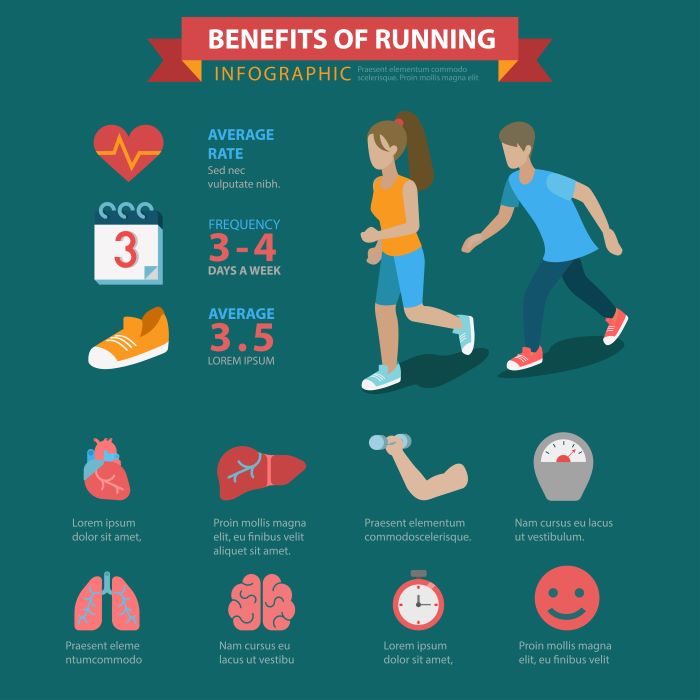Running is often hailed as one of the most effective forms of cardiovascular exercise, offering a plethora of benefits that contribute significantly to overall health and fitness. When considering which exercise is equal to running, it’s essential to understand the unique advantages that running brings to the table.
Firstly, running is a fantastic way to boost cardiovascular health. It strengthens the heart, improves blood circulation, and enhances lung capacity. This aerobic exercise elevates heart rates, making it a highly efficient method to maintain a healthy heart.
Moreover, running serves as a powerful calorie-burner. A person weighing around 155 pounds can burn approximately 300 calories in just 30 minutes of running at a moderate pace. This makes it an excellent choice for weight management and fat loss.
Another key benefit of running is its impact on mental health. The phenomenon known as the “runner’s high” is a real occurrence, where the body releases endorphins during exercise, leading to feelings of happiness and reduced stress levels. Regular running can significantly alleviate symptoms of anxiety and depression.
Additionally, running promotes muscle strength and endurance. It primarily works the muscles in the legs, including the quadriceps, hamstrings, and calves, but also engages the core and upper body when run with proper form. This holistic approach to fitness enhances overall body strength.
For those looking to explore the world of fitness and all its possibilities, visit our website to learn more and get started today! Click here.
Exploring Alternatives to Running for Fitness

While running is an outstanding form of exercise, it may not be feasible for everyone due to various reasons such as joint issues, lack of access to safe running environments, or simply personal preference. Fortunately, there are several alternatives that provide similar benefits, allowing enthusiasts to maintain their fitness journey.
Cycling is one of the most popular alternatives. Whether on a stationary bike or outdoors, cycling is a low-impact exercise that improves cardiovascular health and builds leg strength. It can burn a similar number of calories as running, depending on intensity and duration.
Swimming is another excellent option. This full-body workout is easy on the joints, making it suitable for those recovering from injury or with arthritis. Swimming enhances cardiovascular fitness, builds muscular endurance, and improves flexibility.
Rowing is a fantastic alternative that combines both strength training and cardiovascular exercise. It engages multiple muscle groups, including the legs, back, and arms, while providing a robust aerobic workout. Rowing can effectively burn calories and improve overall fitness levels.
High-Intensity Interval Training (HIIT) can also be a viable substitute. This workout method alternates between intense bursts of activity and short rest periods, providing a time-efficient way to elevate heart rates and promote fat loss. It can include various exercises, making it versatile and adaptable to different fitness levels.
Ultimately, the key is to find an alternative that you enjoy and can commit to consistently. Experimenting with different activities can lead to discovering new passions while reaping fitness benefits.
Comparing Low-Impact Exercises to Running

When considering fitness options, many individuals seek to compare low-impact exercises with running to determine which best suits their needs. Running, while highly effective for cardiovascular health and calorie burning, can be tough on the joints, especially for those who are overweight or have pre-existing conditions.
Low-impact exercises, such as elliptical training, provide a similar cardiovascular workout without the harsh impact associated with running. The smooth, gliding motion of an elliptical machine mimics running while reducing stress on the knees and ankles. This makes it an excellent choice for those recovering from injuries or looking to prevent them.
Walking is another low-impact alternative that is accessible and easy to incorporate into daily routines. It offers numerous health benefits, including improved heart health, increased stamina, and enhanced mood. Walking can be performed anywhere, making it a flexible option for maintaining fitness.
Yoga and Pilates are also valuable low-impact exercises that focus on core strength, flexibility, and balance. While they may not provide the same cardiovascular intensity as running, they promote overall physical well-being and can be instrumental in injury prevention.
In addition to individual preferences and fitness goals, it’s essential to consider the long-term sustainability of the chosen exercise. Low-impact workouts can often be performed more frequently without the risk of overuse injuries, allowing for a consistent fitness regimen.
Ultimately, the best exercise is one that aligns with your personal goals, fitness level, and lifestyle. By exploring low-impact options, you can find a balanced approach to fitness that keeps you moving and enjoying the journey.
High-Intensity Workouts That Match Running

High-intensity workouts have gained popularity for their ability to provide similar benefits to running in a shorter amount of time. These workouts involve bursts of vigorous activity followed by brief recovery periods, making them a time-efficient option for enhancing cardiovascular fitness and burning calories.
High-Intensity Interval Training (HIIT) is one of the most effective forms of exercise that matches the intensity of running. HIIT typically consists of short, intense bursts of exercise, such as sprinting or jumping, interspersed with lower-intensity recovery periods. Research indicates that HIIT can improve aerobic capacity and metabolic health comparable to traditional endurance training.
Another excellent option is circuit training, which combines resistance exercises with cardio movements, allowing participants to alternate between strength and aerobic activities. This approach not only boosts heart rate but also builds muscle strength, making it a well-rounded workout that rivals running.
Tabata training is a specific form of HIIT that consists of 20 seconds of intense exercise followed by 10 seconds of rest, repeated for a total of four minutes. This type of training has been shown to increase both aerobic and anaerobic fitness, providing a powerful alternative to steady-state running.
Lastly, jump rope workouts can also deliver high-intensity cardiovascular benefits. This simple yet effective exercise can increase heart rate rapidly and improve coordination, agility, and endurance, making it a fantastic addition to any fitness routine.
While high-intensity workouts certainly pack a punch, it’s essential to approach them with caution. Gradually increasing intensity and allowing for adequate recovery can help prevent injury and ensure long-term adherence to your fitness regimen.
Choosing the Right Exercise for Your Fitness Goals
When considering which exercise is equal to running, it is crucial to understand that the right choice depends on your individual fitness goals, preferences, and lifestyle. Each type of workout offers unique benefits, and aligning these with your objectives will greatly enhance your fitness journey.
If your primary goal is to improve cardiovascular endurance, activities like cycling, swimming, or rowing can be excellent alternatives to running. These exercises elevate your heart rate and improve lung capacity while being lower impact on your joints.
For those aiming to build muscle strength alongside cardiovascular fitness, incorporating strength training into your routine is essential. High-intensity workouts, such as circuit training or HIIT, combine strength exercises with cardio, making them effective for muscle development while still boosting endurance.
If weight loss is your main objective, consider activities that not only elevate your heart rate but also keep you engaged. Dancing, kickboxing, or even sports like basketball can provide a fun and dynamic way to burn calories while enjoying the process.
On the other hand, if you’re recovering from an injury or seeking a gentler approach, lower-impact activities like yoga or swimming may be more appropriate. These options offer the benefits of movement without putting too much strain on the body.
Ultimately, the best exercise for you is one that you can enjoy consistently. Finding activities that you look forward to will make it easier to stay committed and achieve your fitness goals. Consider trying various workouts to discover what resonates with you, and remember that your fitness journey can evolve over time.
Integrating Various Exercises into Your Routine

Incorporating a variety of exercises into your workout routine is not only beneficial for your body but also keeps your fitness journey exciting. By blending different forms of exercise, you can target multiple muscle groups, prevent workout boredom, and enhance overall performance.
Start by identifying the types of workouts that align with your fitness goals. For instance, if your aim is to improve endurance and you enjoy running, consider adding cycling or swimming to your routine. These activities can elevate your heart rate while providing a break from the repetitive nature of running.
Additionally, integrating strength training is vital for promoting muscle growth and maintaining bone density. Aim to incorporate strength workouts at least twice a week. You could do this by alternating between upper and lower body workouts, or even using bodyweight exercises like push-ups or squats on non-cardio days.
Don’t forget about flexibility and recovery! Activities like yoga or Pilates can significantly improve your range of motion and help prevent injuries. Schedule these sessions to coincide with your more intense workouts for optimal recovery.
Moreover, listen to your body and adjust your routine as needed. If you feel fatigued from running or strength training, replace one of those sessions with a low-intensity workout, such as a leisurely walk or a restorative yoga class.
Ultimately, the key to a successful fitness regimen is variety and balance. By mixing different types of exercises, you can keep your workouts fresh and engaging. Visit our website to learn more and get started today! Click here.


